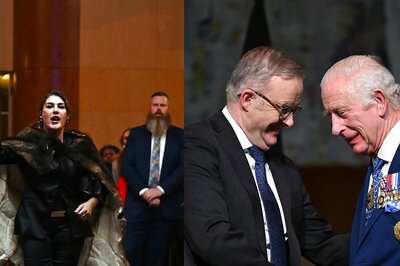
views
Selling designer wear, whitening creams or ethnic clothes is getting increasingly difficult. In a society soaked in OTT content, usual ads just don’t catch consumers’ attention anymore. A distracted society living on ubiquitous content from seasons of series and endless levels of games does not remember advertising. Forget advertising, brains addled with streaming content do not even remember work or routines anymore. Usual emotions of love, nostalgia or cheery-faced celebrities do not add to brand recognition anymore. Especially, if the same few are hawking everything, from undershirts to magical hair oil.
Admen and marketing mavens, ones who make money by selling MSG masquerading as snacks or yellow or red carbon dioxide with water as youthful happiness, have arrived at a new formula—manufacturing dissent, creating controversies, shaping new narratives with a few words and carefully manipulated images.
This is the new model for advertising: catching the national and maybe even international audience by creating dissent in the name of a cause, a higher purpose. A designer tries selling Mangalsutra by showing a homosexual couple wearing it in an attempt to “show inclusivity and empowerment”. This is an attempt by a brand to, as it says, “making heritage and culture a wider conversation”. It’s no longer about selling expensive designer wear but appealing to higher purpose and tagging along with it to catch attention and sales.
Even a century old brand seeks to attract attention for its whitening cream through dissent. As the internet becomes an infinite shopping channel, the lifecycle of old brands is falling into an abyss of abandon. New, craftier direct-to-consumer brands with tonnes of VC funds, lower pricing, better packaging and indistinct quality are taking over. If that was not enough, the new platform has mined the existing consumer base so well that it has launched its own brand mimicking all the USPs of an old earlier-established brand.
Hence, what does a century-old brand or one selling ethnic clothes and designer wear has to do to go viral? To catch everybody’s attention or to go viral, it is important to have a powerful message, something that people will share. People share things that evoke emotions—not just evoke but raise it to an outrageous level. Outrageous is good for the marketing guys, outrage even better. The false surprise at the outrageous response forcing them to withdraw the ad is also part of our post-truth world?
So, what can a staid, old maker of juices-to-whitening cream company do? It sells artificially infused sugar as honey; it certainly cannot choose stunts to attract attention to a whitening cream. It chooses a higher purpose by showing a lesbian couple celebrate Karva Chauth. This twist to a traditional heterosexual festival will certainly attract attention. And it does. Attention from everyone who objects, vociferously voicing dissent about taking over a religious symbolic day. It creates dissonance, stokes controversy and the advertisement goes viral, it is shared on WhatsApp. It catches the attention of the politician, who also desires attention from their constituencies.
The brand chooses to make an advertising film on an age-old Hindu festival about marriage and filial companionship of fasting and celebrating, forcibly inserts its whitening cream usage but also replaces the act of breaking the fast between a husband and wife with two women.
Now, the brand does not sell material that is bought on Karva Chauth as it is a day of fasting. It does not really sell sarees that can be worn on Karva Chauth, or any other product that is used on this occasion. Its choice of the festival is clearly determined by the fact that it is celebrated in many Hindu households, so it would cover a good size of the Indian population.
The marketing geniuses must have discussed the advertising threadbare, especially about their target audience: “women—how we need to make them feel empowered.” We need to make consumers feel that we really understand them. We need to stand with them. We need to stand for a higher cause. What can be a bigger cause to women than a lesbian relationship? Let us celebrate this relationship on a Hindu festival not really made for this.
The marketing mavens and advertising agency must have told the company that brands that attached themselves to causes attract higher premiums. An advertisement piggy backing on a cause to seek attention is like a comedian asking a distracted audience to pay serious attention as he is going to tell a joke.
I am sure the sales people in the company who are realists and in touch with the consumer would have asked questions—some simple, some really silly ones like, is our target audience the LGBTQ+ community? Should we repackage our products in rainbow colours to express solidarity with the community? Do same-sex couples celebrate Karva Chauth now? Does our target audience empathize with this cause enough to go against the sensibilities of a religion? Will we sell crores of products because we are subverting a Hindu festival in a conservative country? Will there be opposition or angry reaction by Indians if we misappropriate their religious symbolism?
There might have been some other strong questions about the impact or reaction, but when it comes to marketing genius out to save a brand from oblivion, I am sure they would have been brushed aside. After all, in a content-soaked world, it is so important to stand apart, create a new narrative, spark a controversy, and create dissent where none existed.
A Shift in Mumbai’s Ad World
While three occurrences of riding causes to manufacture dissent is not a trend, it does show a shift in the way Mumbai’s advertising world is thinking. With mass media dead, traditional media shrinking, dopamine-addicted millennials are driving trends. To shake them, we need to shock them. Little realizing that there are multiple Indias at play here. It’s not a singular audience of people like them.
The third example is a brand selling ‘ethnic’ clothes. Its target audience is young, recently settled and confused people who want to show their Indianness by buying ‘handicrafts’. A trend that has been well-crafted by this company founded by American expats. Who can tell Indians about how to be Indian than the Americans! But in a crowded market where ethnic Indian cholis and chunnis are being made in Vietnam and China, the brand has to stand out, especially as direct-to-consumer (D2C) brands import ethnic-looking products and sell it at one third the price online. How does it attract consumers to its stores and buy the same stuff at three to four times the price and still feel good about it? Enter the eponymous marketing geniuses with the solution to rebrand the biggest Hindu festival Diwali in Urdu.
A stroke of genius, if ever there was one. A big Hindu, no the biggest festival is rebranded with an Urdu name and models wearing ethnic wear are photographed with it. Urdu, a language more associated with Muslims. This is a huge step—it must have been actively debated internally and with the advertising agency.
Questions must have been asked, like: Will using Urdu help us reach our target audience? How many of our consumers read, understand Urdu and also celebrate this festival? Is Urdu a hip, fashionable language for our consumers? Will consumers seeing this advertisement buy more of their products or associate more with the brand?
After all that is the purpose of advertising: to sell more or make the brand more recognizable. In the infinite wisdom of marketing mavens who can sell concentrated sugar and preservatives as fresh fruit juice, this was the solution. They must have advised that not only will such an advertisement create enormous brand recognition but will go viral. It will be shared and talked about on social media. Its resonance will be so high that news media will debate, discuss and write reams about it. Millions of ethnic wear will fly off the shelves for Diwali as people rush into the stores to buy them as Diwali gifts.
The marketing genius might have said that it would even raise the ethnic wear brand to one that stands for social cohesion and harmony between culture and languages. The company will benefit from this social elevation of its brand and get more distributors and shopkeepers to stock its goods. Millennials will rush for such a clever piece of communication and tattoo the brand on their foreheads as a mark of higher purpose.
Not an Isolated Incident of Ignorance
Higher purpose is served as soon as the ad is released. Social media goes into a tizzy, political leaders clobber the ad, news channels run debates and discussions, celebrity columnists comment on an advertising film as if it was a piece of art. Outrage brigade brays about how it is about free speech and the politician and religious leaders are being intolerant and silly. Comedians on TV debates talk about freedom of speech and give speeches about a dark world descending.
The for-and-against lobby makes it a religious, political and even a judicial issue. So much so that a Supreme Court judge talks about it as a sign of intolerance. Little realizing how they have been part of a game by the Admen.
Ultimately, the marketing mavens have to withdraw the advertisement. But brand recall is at a record high, now their higher purpose is served. They win because even if the advertisement is withdrawn, the ad remains alive in the memory of the people because of the controversy. And, archived for perpetuity on the internet.
If you think this is an isolated incident of ignorance of a few well-meaning executives misunderstanding issues, there is more.
Brands were created to have a persona, an aspirational one, that the young and impressionable wanted to be. They sometimes also signified a lifestyle that the middle age and the middle class wanted. They were supposed to fill in a gap and become a goal. Now the creatives in the advertising world are trying so hard to make it about causes and higher purpose that they are losing their very connect with the consumer. It’s fearful to imagine what the mavens will bring to us in the metaverse.
The author is CEO, Center for Innovation in Public Policy a think tank based out of Gurgaon. The views expressed in this article are those of the author and do not represent the stand of this publication.
Read all the Latest Opinions here




















Comments
0 comment